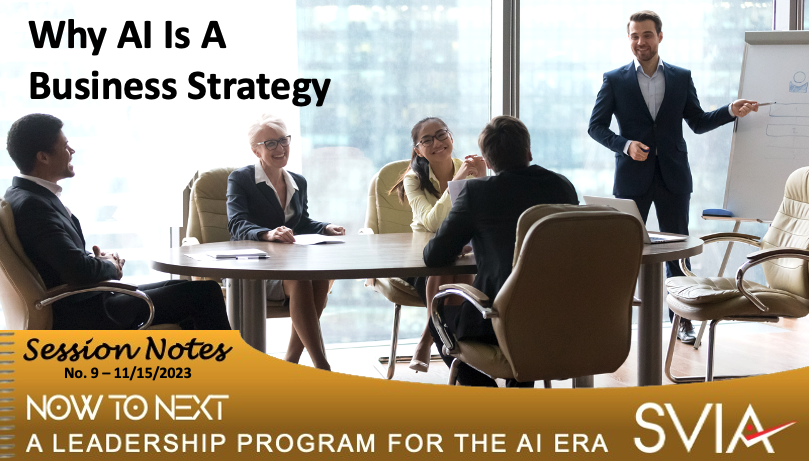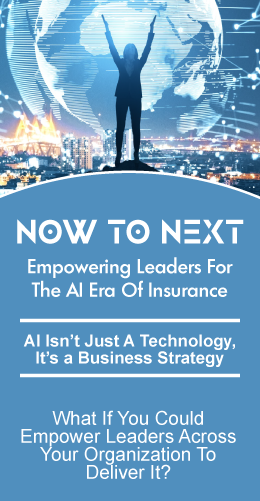In an era where AI is literally redefining industries, insurance executives who see AI as mere technology rather than a core driver of future business strategy are putting their business at risk. Over the next 3-5 years, AI will permeate almost every aspect of insurance. This includes Customer Engagement, Marketing, Underwriting, Claims, Real-time Data retrieval, and more.
The IT department will make recommendations, but the planning strategies for how and when AI will be incorporated and integrated into the business plan going forward need to be a senior-level management decision. One that is not driven just by IT. As a senior executive, if you are not looking into the business strategy side of this now, your company will be behind the competitive eight ball not too far in the future.
AI is more than a technological upgrade; it’s a strategic asset transforming every aspect of insurance and your business. In this blog, we explore why integrating AI into your business strategy is not just an option but a necessity for future-proofing your company and staying ahead in the competitive market.
AI as a Technology Add-On: A Misconception in Insurance
In many insurance departments, AI is often viewed as just another technological tool – an add-on to existing systems rather than a fundamental business driver. While it’s easy to get excited about AI’s ability to enhance existing operations by augmenting existing processes, customer interactions, and risk assessment, its competitive impact will be far greater than that.
Many executives underestimated the transformative and strategic impact of the internet and mobile technology. Instead, they conducted business as usual, letting their organizations focus principally on using websites and mobile apps as simple extensions of existing processes. They overlooked the fact that these powerful forces were redefining products and services, industries, and the boundaries between them. AI’s ability to disrupt is far greater and will come far faster than those technologies. That oversight cost their companies dearly.
Departmental Impact of AI
Marketing and Customer Engagement in Insurance: A Strategic AI Approach: Traditionally, marketing and customer engagement in insurance have relied on broad strategies and generalized customer interactions. AI’s integration, however, offers an opportunity to shift this paradigm. Instead of just enhancing existing processes, AI will strategically redefine them. It will transform the customer experience from passive policy management to active risk management and support.
It allows for hyper-personalized engagement and product offerings, adapting to customer needs in real-time. This shift moves the industry from merely reacting to customer claims to proactively working with customers to predict, prevent, and mitigate risks, deepening and accelerating the value provided. Using AI this way doesn’t just improve efficiency; it fundamentally changes the nature of value creation in insurance.
This evolution enhances the customer experience and creates a significant competitive edge. Insurers who fail to adopt this strategic approach will lose the ability to deepen customer relationships and innovate risk management, leaving them behind the competitive field.
Supporting Agents and Brokers with Strategic AI Integration
In supporting agents and brokers, the strategic integration of AI signifies a shift from conventional support tools to advanced, dynamic systems. AI can provide agents and brokers with real-time data insights and predictive analytics, enabling them to offer tailored advice and products to clients. This proactive approach not only streamlines the work of agents and brokers but also enhances their ability to meet evolving customer needs. Companies that fail to integrate AI strategically in this area risk limiting their agents’ effectiveness and falling behind in a market where personalized, data-driven client interaction is increasingly the norm.
Risk Assessment and Underwriting: Embracing Real-Time, Contextualized AI
The strategic use of AI in risk assessment and underwriting is evolving into real-time, contextualized analysis. By employing Swarm AI, where specialized AI systems collaborate (e.g., focusing on climate, traffic conditions, driver behavior, vehicle safety, repair costs), insurers can achieve a comprehensive risk profile. This approach enhances underwriting precision and shifts the industry towards predictive and preventive risk management. Insurers not adopting such advanced AI strategies risk falling behind, as they miss out on leveraging real-time data for more effective and customer-centric underwriting. This evolution is vital for insurers aiming to lead in a market that values innovation and responsiveness.
Product Design and Development: Leveraging AI for Market-Responsive Innovation
AI’s role in product design and development extends to monitoring and predicting global forces, consumer trends, behaviors, and sentiment. By combining this with data produced by the AIs used in underwriting and claims, insurers can identify emerging market needs and preferences. This data-driven approach, powered by AI, enables the creation of products that are not only highly personalized but also adaptable to changing consumer expectations. Failing to take this approach disconnects insurers from the rapid evolution of insurance offerings. The result is that they will lose their relevance and competitive edge in an increasingly customer-centric industry.
Claims Management: AI-Driven Predictive and Proactive Approach
AI’s potential extends beyond processing claims to predicting and preventing them. AI systems can anticipate potential damage and recommend preventative measures, offering a more proactive approach to risk management. In the event of a claim, AI can support customers holistically, cueing up necessary services and support and invoking parametric responses. This includes coordinating with other AI systems to deliver services and support and offering transparency throughout the claims and recovery process. Claims are a critical area in terms of building or losing customer loyalty. Claims will become a key competitive battleground as insurers begin to leverage and integrate AI capabilities throughout the value chain. Not leveraging AI strategically here will open insurers to a catastrophic loss of customer loyalty and referrals.
Insurance Operations & The Strategic Use of AI
Strategically leveraging AI in insurance operations creates customer value and competitive advantage in several key areas. We have already discussed several of them, including Customer Service, Claims Processing, and Risk Management. In addition, it will also shift policy management from a static and manual process to a dynamic data-driven one.
These AI-driven improvements in operations not only heighten the customer experience but also position insurers as market leaders through innovation and enhanced service delivery. This sets the stage for a deeper exploration into how AI in premium investments, as a specific operational area, further contributes to this competitive edge.
We will use premium investments as an example of strategically using AI operations. Doing so provides a significant competitive advantage. AI’s capability to analyze complex market dynamics and risk factors in real-time empowers insurers to make more precise and profitable investment decisions. This strategic approach enhances financial performance and improves risk management. By maximizing returns and effectively managing risks, insurers strengthen their financial stability and can offer more competitive premiums. This provides a significant competitive edge in the market..
The Necessity of Senior Leadership in AI Strategy
In the insurance industry, each department holds potential value through strategic AI integration. From underwriting’s enhanced risk assessments to claims’ predictive analytics, AI strategically applied at a departmental level paves the way for more personalized, efficient services. However, the true transformative power of AI emerges when its application is not confined to silos but is part of a unified, company-wide vision.
This comprehensive approach ensures that all departments align their AI-driven innovations towards a common goal: evolving insurance products and services that adapt in real-time to changing customer needs. A cohesive AI strategy, led by senior leadership propels the entire organization forward in the AI arms race.
By fostering a culture of continuous evolution, where AI continually refines and redefines products and services, insurers can achieve a significant competitive advantage. This approach leads to an ecosystem where insurance solutions are not static but dynamically evolve, offering customers unparalleled value and flexibility.
In this landscape, senior executives play a pivotal role. Their commitment to integrating AI at the macro level, coupled with investments in AI infrastructure and ethical AI practices, sets a direction for the entire company.
Building the Business Case for a Unified AI Strategy
In the paradigm shift towards AI-driven insurance, interoperable AI-empowered systems across both internal operations and the external value chain are crucial. These integrated systems provide a comprehensive view of customer data and insights, crucial for informed decision-making. They streamline operations, reducing time and costs, which directly translates to enhanced customer experiences through consistent and personalized interactions. Additionally, the agile response of these interconnected systems to market changes ensures that insurers remain competitive and relevant. This interconnectedness also fosters innovation, as insights shared across the value chain leading to the development of new, more adaptive insurance products and services.
Starting Point for Building Executive Understanding and Support
As an individual department or business leader, you can’t do the work required to bring this unified approach to integrating AI into the overall business strategy by yourself. You will need the help and support of other executives. Here’s some things you can do to advocate for AI as a core part of overall business strategy among fellow executives:
- Highlight AI’s Business Impact: Share how AI can drive growth and efficiency.
- Use Success Stories: Present case studies where AI integration led to significant business improvements.
- Stress Market Competitiveness: Emphasize the need for AI to stay competitive.
- Develop a Strategic AI Roadmap: Outline a clear, actionable plan for AI integration.
- Showcase ROI and Efficiency Gains: Provide data-driven projections of AI’s financial benefits.
- Address Ethical and Compliance Aspects: Highlight the importance of responsible AI usage.
- Cultivate a Culture Receptive to Innovation: Advocate for an organizational mindset that values and embraces technological advancements.








